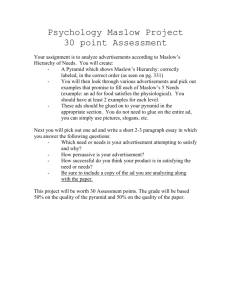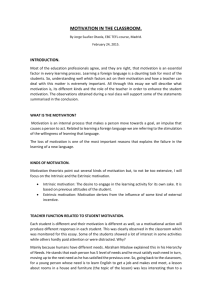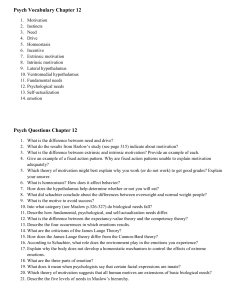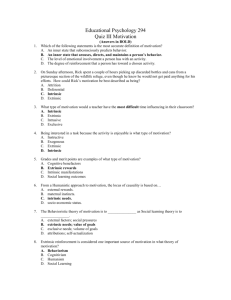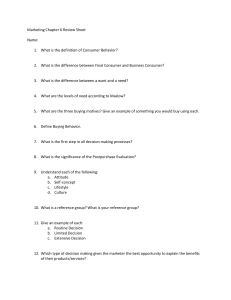129 EMPLOYEE MOTIVATION IN THE COMPANY. STUDY CASE
advertisement
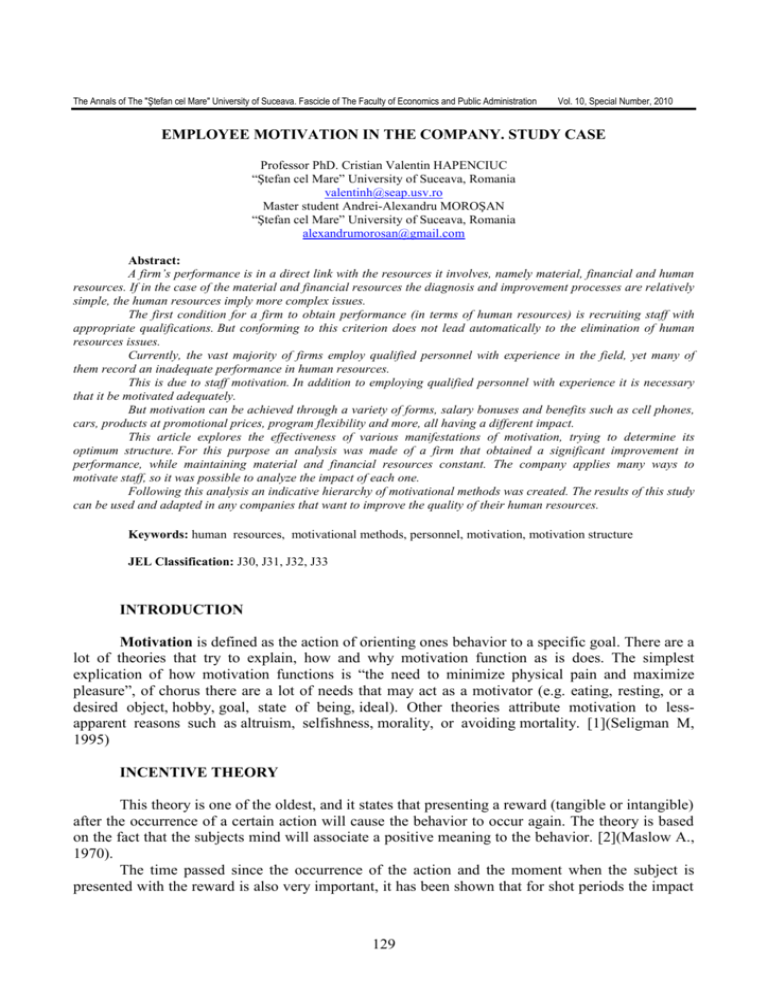
The Annals of The "Ştefan cel Mare" University of Suceava. Fascicle of The Faculty of Economics and Public Administration Vol. 10, Special Number, 2010 EMPLOYEE MOTIVATION IN THE COMPANY. STUDY CASE Professor PhD. Cristian Valentin HAPENCIUC “Ştefan cel Mare” University of Suceava, Romania valentinh@seap.usv.ro Master student Andrei-Alexandru MOROŞAN “Ştefan cel Mare” University of Suceava, Romania alexandrumorosan@gmail.com Abstract: A firm’s performance is in a direct link with the resources it involves, namely material, financial and human resources. If in the case of the material and financial resources the diagnosis and improvement processes are relatively simple, the human resources imply more complex issues. The first condition for a firm to obtain performance (in terms of human resources) is recruiting staff with appropriate qualifications. But conforming to this criterion does not lead automatically to the elimination of human resources issues. Currently, the vast majority of firms employ qualified personnel with experience in the field, yet many of them record an inadequate performance in human resources. This is due to staff motivation. In addition to employing qualified personnel with experience it is necessary that it be motivated adequately. But motivation can be achieved through a variety of forms, salary bonuses and benefits such as cell phones, cars, products at promotional prices, program flexibility and more, all having a different impact. This article explores the effectiveness of various manifestations of motivation, trying to determine its optimum structure. For this purpose an analysis was made of a firm that obtained a significant improvement in performance, while maintaining material and financial resources constant. The company applies many ways to motivate staff, so it was possible to analyze the impact of each one. Following this analysis an indicative hierarchy of motivational methods was created. The results of this study can be used and adapted in any companies that want to improve the quality of their human resources. Keywords: human resources, motivational methods, personnel, motivation, motivation structure JEL Classification: J30, J31, J32, J33 INTRODUCTION Motivation is defined as the action of orienting ones behavior to a specific goal. There are a lot of theories that try to explain, how and why motivation function as is does. The simplest explication of how motivation functions is “the need to minimize physical pain and maximize pleasure”, of chorus there are a lot of needs that may act as a motivator (e.g. eating, resting, or a desired object, hobby, goal, state of being, ideal). Other theories attribute motivation to lessapparent reasons such as altruism, selfishness, morality, or avoiding mortality. [1](Seligman M, 1995) INCENTIVE THEORY This theory is one of the oldest, and it states that presenting a reward (tangible or intangible) after the occurrence of a certain action will cause the behavior to occur again. The theory is based on the fact that the subjects mind will associate a positive meaning to the behavior. [2](Maslow A., 1970). The time passed since the occurrence of the action and the moment when the subject is presented with the reward is also very important, it has been shown that for shot periods the impact 129 The Annals of The "Ştefan cel Mare" University of Suceava. Fascicle of The Faculty of Economics and Public Administration Vol. 10, Special Number, 2010 is greater than for longer ones. If this cycle of action–reward is repeated it is possible to convert that action into a habit. [3](Goldthorpe, J.H. and others, 1968) This theory depicts motivation as a very simple process, but in reality there are a lot of factors that influence it. There are a lot of motivational techniques and it is hard to decide which one is the optimum for a given situation. [4](Kerr S., 1995) EMPLOYEE MOTIVATION One of the most important uses of motivation is in a company. Organizations employ workers to perform certain tasks; these workers need to be motivated in order to perform their tasks with maximum productivity. Of chorus workers need to be kept in the organization for a long period of time, for this process motivation is once again responsible. The traditional motivator for a worker is his salary, but in many cases that isn`t enough. Companies use a lot innovating tactics to keep their productivity at a maximum level. Some of them imply material rewards, others imply psychological motivators.[5]( Weightman, J., 2008) Analyzing from the perspective of the motivational factor we can speak of two types of motivation: Intrinsic motivation is generated by a factor that comes from within the subject (beliefs, feeling that what he does is important, modality, the perspective of learning something new). Extrinsic motivation is generated by a factor that comes from the exterior (e.g. salary, material rewards, good reviews). [6](Lepper, M.R. and others, 1973) BUSINESS A very important theory in the field of motivation is Maslow`s pyramid. In his work Maslow has created a hierarchy of needs felt by an individual. [7](Maslow A., 1970) At the base of his pyramid Maslow put physiological needs; for an individual found under their constraint money is a perfect motivator. But after these need are satisfied the individual will advance on Maslow`s hierarchy and his needs will change, this implies the fact that the motivator will change as well [8]( Goldthorpe, J.H. and others 1968). At higher levels of Maslow`s pyramid, are placed needs that are satisfied with praise, respect, recognition and empowerment, money having a small impact [9]( Steinmetz, L., 1983). EXPERIMENTS Given the extremely important functions played by motivation and its complexity, over time there have been a lot of researches and experiments. One of these experiments was made by Sam Gluxberg. He used the "candle problem" (created by psychologist Karl Druncker in 1945 to study the functional fixedness).This problem forces the subjects to go beyond the obvious usefulness of objects and use their creativity to determine other functions. More specifically in the "Candle Problem" the subject is placed in a room with a table, on which are three items, a candle, a box of Figure 1 – The Candle Problem matches and a box of thumbtacks (like in Figure 1). They must fix the candle to the wall so that the wax does not run on the table. 130 The Annals of The "Ştefan cel Mare" University of Suceava. Fascicle of The Faculty of Economics and Public Administration Vol. 10, Special Number, 2010 The solutions that are first tested by the subjects are: 1. Lateral melting the candle and try to stick it to the wall; 2. Fix the candle to the wall with thumbtacks; But none of them work. After an average time of about five minutes subjects find the solution, the box of the thumbtacks is an object to be used in solving the dilemma, the solution is depicted in figure 2. To solve this problem it is necessary to be creative. Gluxberg found a very interesting use for this experiment, he took two groups of people and put them to solve this problem. To the first group he said that the top 25% who finish will receive $ 5 and the first person to finish will receive $ 20. The second group was told they would be timed to determine the average time to resolve this problem. The results were very interesting, the group which was promised the rewards, had pour performance, individuals within the first group, took about 3.5 minutes longer to find the solution.[10]( Pink D., 2009). Gruxberg determined from this experiment that extrinsic motivations (such as material Figure 2 - Solution of Candle Problem rewards), put pressure on individuals, having negative effects on creativity. To prove this first hypothesis, Gluxberg devised a second experiment. This time he used a simplified version of the "Candle Problem" depicted in figure 3 (in this simplified version, the thumbtacks are out of the box, making the solution obvious). Repeating the experiment under similar conditions, but simplifying the problem, Gluxberg achieved a result which reinforced the hypothesis. Using a simple problem which requires no creativity the first group (that was motivated extrinsically) obtained much better results (accounting for much better times). These results supported his hypothesis. For tasks whose solution is obvious extrinsic motivations are working as they should (increasing performance), but for tasks whose solution is more complex, extrinsic motivation backfires, having negative effects on performance [11]( Pink D., 2009). Given Gluxberg conclusions in 2005 a team of researchers from Massachusetts Institute of Figure 3 – Simplified Candle Problem Technology, led by D. Arily conducted a similar experiment. This time they used several games, some of which required only motor skills, while others required in addition to motor skills, cognitive abilities. They used three types of rewards. The MIT researchers conclusions were similar, as long as they used only games that required motor skills, extrinsic motivations operated as expected (the higher the reward conducted to the highest 131 The Annals of The "Ştefan cel Mare" University of Suceava. Fascicle of The Faculty of Economics and Public Administration Vol. 10, Special Number, 2010 performance), but when using games that required cognitive abilities, rewards had negative effects. For complex games (which required cognitive skills) the best performances was recorded for groups that weren’t offered any rewards. Some researchers suggested moving the experiment to another country, where the standard of living would be lower, this suggestion being made on the basis that the U.S. standard of living is quite high and extrinsic motivations (such as material rewards) have lost some of their effect. As a result a set of research was conducted in India, a country with a low living standard and a sum of money which is irrelevant to an American, is significant for an Indian. In India the results of the experiment were identical to those in the U.S.. Therefore it is not a question of living standards. The conclusion of the two experiments is that if the task is complex the motivation uses must be intrinsic (within the employee) and if the task is simple the motivation uses must be extrinsic [12]( Heyman J., Ariely D., 2004). But this conclusion is lacking applicability. It is hard to believe that an employee operating only on intrinsic motivation will perform tasks in the interest o a company for a period of time. In order to prove this point of view we take a look at Malov`s theory. "Maslov's pyramid” (figure 4)(hierarchy of needs generates a default behavior and a certain sensitivity to motivation) is another theory uses in human resources management. According to Maslow's pyramid individuals will be motivated in the first phase of basic needs (needs such as food, clothing, security), those on the first two levels of his pyramid. Only after these two needs will be satisfied they can advance. In an attempt to meet these two basic needs, individuals will be attracted to extrinsic motivations. Later, after satisfying the first two levels, they will advance. Only in this second phase they will present a greater openness to intrinsic motivation. It is worth mentioning that in this second phase they will have to maintain the first two needs at an optimum level Figure 4– Maslow`s Pyramid of satisfaction, therefore they will maintain a certain sensibility to extrinsic motivation [13](Maslow A., 1970). Gluxberg used in the experiment subjects, who most likely had past the first three levels of the pyramid, therefore they were not affected by strong constraints such as lack of food or security. Graph 1 - Sensibility 132 The Annals of The "Ştefan cel Mare" University of Suceava. Fascicle of The Faculty of Economics and Public Administration Vol. 10, Special Number, 2010 Graph 2 – Sensibility If we were to superpose the two theories, that of Maslow and Gluxberg we get a more complex scenario, which would be more realistic. Individuals in the first phase will be very sensitive to extrinsic motivations, once these needs on the first level of Maslow's pyramid are met, their sensitivity will change to intrinsic motivation (this sensitivity will vary in direct proportion to the level attained in the hierarchical pyramid). But after this shift, the sensitivity for intrinsic motivation will vary depending on the complexity of tasks individuals have to perform. A graphical representation is depicted in graph 1 and graph 2. These developments are indicative. Also, an employee can carry out activities with a medium or high level of creativity only when his needs are located at least at the third level (or higher) on Maslow's pyramid. In the motivation process it is very important to take into account the specific work undertaken. Employees are extrinsically motivated (rewards) and for those carrying out a complex task which requires cognitive and creative functions it is recommended the use of intrinsic motivation, extrinsic showing multiple limitations. Gluxberg's conclusion is a bit naive and inappropriate application (for cognitive and creative activities to relate to intrinsic motivation, extrinsic ones having a negative effect), but combined with Maslow's theory, it takes on a new dimension that can have great practical utility. STUDY CASE 1. 2. 3. 4. Salary bonuses Life ensures Mobile phone Company car Table 1 – Forms of Motivation 1. To demonstrate the functionality of the above principles, we conducted a study on a company with 60 employees. We chose a company that has two divisions: automotive service (35 staff) and an auto sales (25 employees), the choice was based on the consideration that the service division performs tasks 133 2. 3. 4. 5. Intrinsic Motivations Great importance on communication Employees have the possibility to propose improvements Employees are consulted when the firms strategy is updated Flexible program Opportunities of career advancements Extrinsic Motivations The Annals of The "Ştefan cel Mare" University of Suceava. Fascicle of The Faculty of Economics and Public Administration Vol. 10, Special Number, 2010 does not require much cognitive and creative functions (vehicle diagnoses being provided by a computer, other operations being described by the vehicle service manual), and the sales unit witch perform opposite task, they must be very creative in direct marketing, addressing customers so as to persuade them to opt for products distributed by the company. Another consideration on which this company was chosen is the forms of motivation applied. In table 1 these forms of motivation are enumerated. It is worth mentioning that the company allocates similar resources for the two forms of motivation (graph 3). Within this company a survey was conducted among all employees, trying to determine the effectiveness of various forms of motivation. Employees were applied a questionnaire which contained several questions, one section include a list of all forms of motivation applies, they were asked to tick a degree of effectiveness for etch one, from their point of view. The results of this query support Gluxberg theory, the employees from the sales department have agreed intrinsic motivation is more effective than extrinsic motivation, while those in the service department had a reverse reaction. Graph 3 – Forms of motivation If we were to relate only to Gluxberg`s applaied theory the general motivation of employees from this company should be low, due to the fact that this company applies the two forms of motivation equally. But the same survey also had a section to quantify the overall motivation of employees (graph 4). As shown, Gluxberg`s theory is not valid in practice. The experiment studied motivation isolated from other factors. If we were to relate the conclusions Graph 4 – General Satisfaction derived from overlapping Gluxberg with Maslow's theory, the results are validated. The company applies the two forms of motivation (approximately equal) and obtains a relatively good motivation (approximately 75% of employees). As a possibility of improving employee motivation in this company, it is recommended to easily apply the two forms of motivation distinct among the two divisions (graph 5). It's hard to say which would be optimal; it must Graph 5 – Optimum distribution of be found by repeated tests. motivation forms 134 The Annals of The "Ştefan cel Mare" University of Suceava. Fascicle of The Faculty of Economics and Public Administration Vol. 10, Special Number, 2010 CONCLUSIONS The results of a series of experiments conducted under controlled conditions are not always appropriate to be applied in practice, these experiments provide very important contributions, but they should be correlated with both existing theory and the issues identified in the companies. Gluxberg's experiments have made very important contributions on forms of motivation that should be applied in modern society. But, the solutions given by his experiments, can`t be applied in practice, they are not taking into account all the factors that act on an employee. If his conclusions are related to existing theory they become feasible, consequently, suited to the situation found in companies. Managers must take into account the situation of employees, the needs that they show (placing them on a certain level of Maslow's pyramid), but also the specific work performed by them (involving cognitive and creative activities or not). Following these findings, managers are able to identify the predominant form of motivation recommended for their company. And then through successive adjustments to identify the optimal point (these adjustments are necessary, because economic theory provides an indicative distribution, every company and every employee has certain features that are hard to take into account). BIBLIOGRAPHY 1. Baumeister R.F., Vohs K.D. – Handbook of self-regulation: Research, theory, and applications, Guilford Press, New York, 2004 2. Burciu A., Prelipcean G., Bostan I., Hapenciuc V., Chaşovschi C., Roman C., Popescu M., Vancea R., Dîmbu D., Năstase C. – Introducere în Management, Editura Economică, Bucureşti, 2008 3. Carver C. S. Scheier M. F. – On the self-regulation behavior, Cambridge University Press, New York, 2001 4. Cofer C., Appely M. – Motivation: Theory and Research, John Wiley & Sons, New York, 1967 5. Goldthorpe, J.H., Lockwood, D., Bechhofer, F. and Platt, J. - The Affluent Worker: Attitudes and Behaviour, Cambridge University Press, Cambridge, 1968 6. Heyman J., Ariely D. –Effort for Payment: A Tale of Two Markets, Psychological Science 15, 2004 7. Kerr S. - On the folly of rewarding A, while hoping for B, Academy of Management Executive, New York, 1995 8. Knghts D. and Willmott H. - Organizational behaviour and management, Tomson Learning, London, 2007 9. Lepper, M.R., Greene, D., Nisbett, R.E. - Undermining children's intrinsic interest with extrinsic rewards: A test of the overjustification hypothesis, Journal of Personality and Social Psychology, 28(1), 1973 10. Maslow A. - Motivation and Personality, Harper & Row, New York, 1970 11. Pink D. – Drive: The Surprising Truth About What Motivates Us, Penguin Group Incorporated, New York,2009 12. Seligman M. - Learned Optimism,Alfred A. Knopf, Inc., New York, 1995 13. Steinmetz, L. - Nice Guys Finish Last: Management Myths and Reality, Horizon Publications Inc., Boulder, Colorado, 1983 14. Weightman, J. - The Employee Motivation Audit, Cambridge Strategy Publications, Cambridge, 2008 15. www.wikipedia.org 135 The Annals of The "Ştefan cel Mare" University of Suceava. Fascicle of The Faculty of Economics and Public Administration 16. www.ted.com 136 Vol. 10, Special Number, 2010
